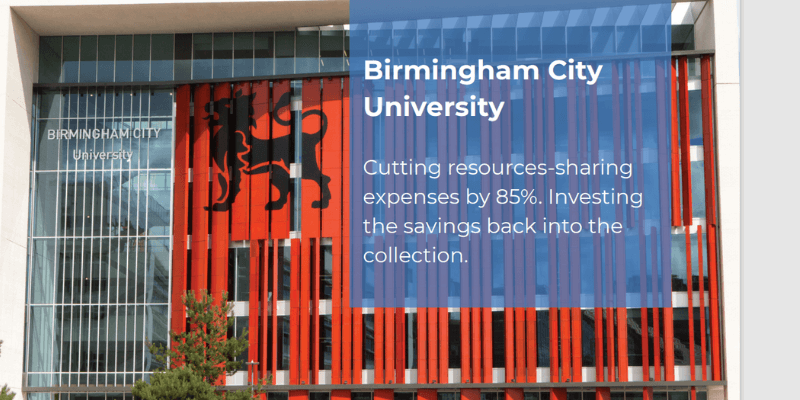Librarians are put in a tight spot. On one side, students expect more resources from their library, delivered faster. On the other, libraries are facing severe budget cuts. So how can staff manage both at the same time?

Take a fresh approach to collection development. Expanding the collection doesn’t necessarily mean acquiring new titles. “Collaborative collection development,” “shared collections,” or “collective collection” may be resource sharing terms you have heard lately. In the article “Collaborative collection development: current perspectives leading to future initiatives,” published in a 2020 issue of the Journal of Academic Librarianship, Helen N. Levenson and Amanda Nichols Hess explains more about this concept:
“As academic libraries continue to face acquisition budget challenges, collaborative collection development (CCD) offers greater opportunities to fulfill the core role of library collecting and collection management, namely, to provide enhanced access to the widest variety of relevant resources in the most cost-responsible manner possible.”
So, how can you bring an expanded “shared collection” to your library?
For staff challenged by tighter budgets, Kip Darling, Library Supervisor specializing in library systems and interlibrary loans at Birmingham City University (BCU), UK, shares how he took advantage of the Ex Libris shared collection.
The library activated a virtuous cycle when joining the Ex Libris resource sharing community and adopting RapidILL. Kip says:
“RapidILL has been a real game changer for Birmingham City University’s Library & Learning Resources department, helping us to “Go Go Go” and meet our customers’ Interlibrary Loan needs while saving money, time, and increasing our network exponentially.”
What is the resource sharing strategy Kip names “Go Go Go”?
- Go farther!
Connect with more than 600 institutions worldwide, including 1/3 of all UK academic libraries. Give students access to the collections of your neighbors and of libraries thousands of miles away, at no additional cost for the library.
- Go faster!
Provide students with the resources they need in a few hours with an interlibrary-loan automation system based on smart prioritization. The comment Kip hears the most from his users? “Thanks for supplying so quickly.”
- Go cheaper!
Library resource sharing fees don’t have to be transaction-based. Moving to a set annual fee has helped Kip and his team save 85% of their resource sharing budget.
Delve into Kip’s insights as he analyzes how his library saves 85% on resource sharing fees. Learn how the library invests the savings back into building the internal collection. Read the BCU testimonial.
About RapidILL by Ex Libris, part of Clarivate:
RapidILL is an interlibrary-loan automation system tailored for article and book chapter requests. With more than 600 members in the community, libraries fulfill 95% of their requests, in 10 hours on average.
________________________________________________________________________________________________________________________________
What’s the difference between RapidILL and Rapido?
Ex Libris unifies its library resource sharing community under Rapido. Rapido offers the automation capabilities of RapidILL, while making it easier for patrons to borrow titles:
- Gain time and budget back to invest in your library. Rapido integrates the RapidILL technology with your ILS to connect you to libraries worldwide. It automatically processes interlibrary loan requests from patrons.
- Give more independence to your users. They can borrow physical and digital titles on the library’s interface in two clicks. Rapido gets rid of the interlibrary loan forms.
Is Rapido the right fit for your library? Watch the video. Learn more about the Ex Libris integrated library system.




